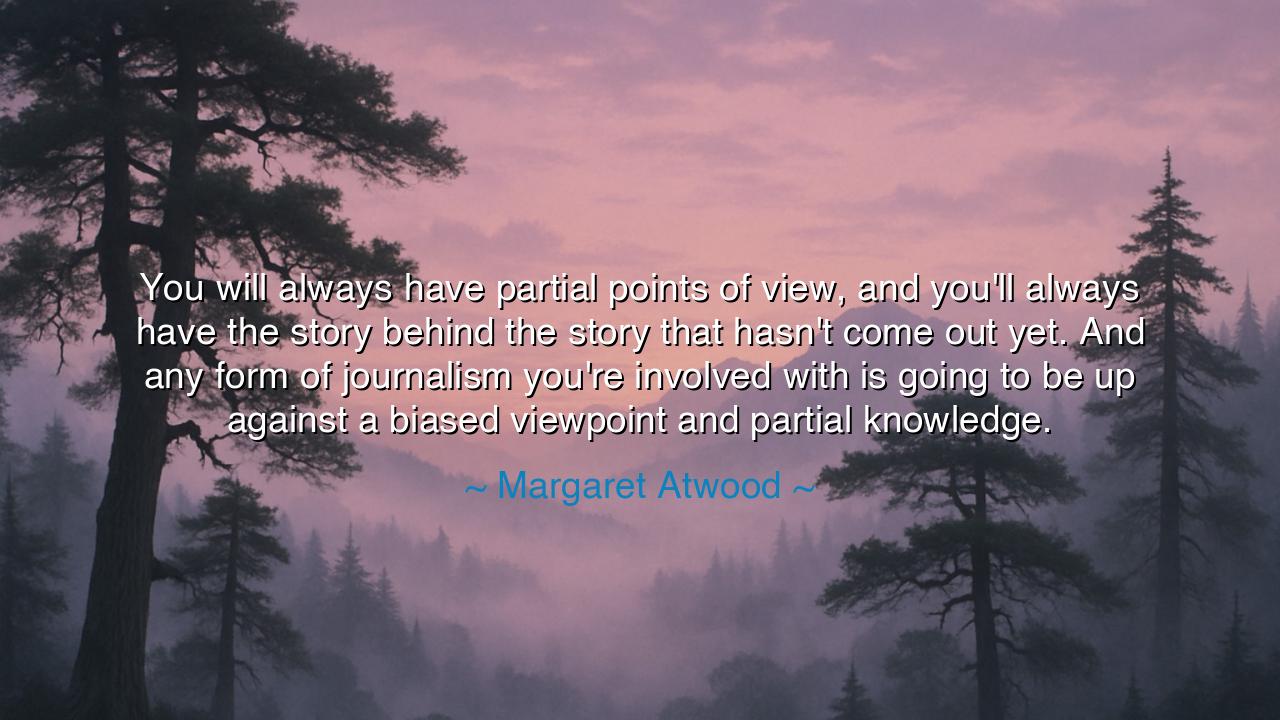
You will always have partial points of view, and you'll always
You will always have partial points of view, and you'll always have the story behind the story that hasn't come out yet. And any form of journalism you're involved with is going to be up against a biased viewpoint and partial knowledge.






When Margaret Atwood declared, “You will always have partial points of view, and you'll always have the story behind the story that hasn't come out yet. And any form of journalism you're involved with is going to be up against a biased viewpoint and partial knowledge,” she spoke as both a storyteller and a prophet of truth. Her words reveal the eternal struggle of human understanding — that truth, no matter how earnestly sought, is always fragmented, seen through the lenses of time, belief, and limitation. She reminds us that knowledge, like light passing through glass, is refracted by the shape of those who hold it. The journalist, the historian, and even the witness are all prisoners of their own perspective.
The origin of this insight can be found in Atwood’s lifelong engagement with the written word — both as a novelist who examines power, perception, and narrative, and as a commentator on media and truth. Living through eras of political unrest, technological transformation, and information warfare, Atwood saw that the story behind the story is not a metaphor but a reality. Every event has layers; every voice hides others beneath it. The press, she observed, does not uncover absolute truth but only its contours — shadows cast by deeper stories still unseen. Thus, her words are not cynical; they are humble, a recognition of the limits of even the most sincere inquiry.
In the ancient world, the philosophers understood this condition well. Herodotus, the “father of history,” wrote his chronicles not as unshakable fact, but as a gathering of tales told from many mouths — often contradictory, always incomplete. He recorded not certainty, but multiplicity. Later, Plato warned in his allegory of the cave that human beings see only shadows on the wall, mistaking them for reality. Atwood’s reflection echoes this ancient wisdom: that no human can hold the whole truth, for truth itself is too vast, too living, to be captured by a single perspective. What we call “bias” is simply the shadow of our humanity cast across the field of our perception.
In her words, there is also a warning — one that the modern age urgently needs. For we now live in a world of endless information and fractured narratives. Every headline is an angle; every broadcast, an interpretation. The danger does not lie in bias itself — for bias is inevitable — but in the illusion of objectivity. The one who believes himself free from bias is the most deceived of all. True wisdom, Atwood teaches, lies not in claiming to see the whole picture, but in remembering that others see what we cannot. Thus, the pursuit of truth becomes not conquest, but collaboration — a weaving together of many voices, many eyes, many experiences.
History offers us examples of what happens when this humility is forgotten. When rulers silence dissent, when nations permit only one narrative, the world darkens. The Inquisition, totalitarian regimes, and even modern propaganda machines have all thrived by erasing competing points of view, replacing truth with a single, blinding light that destroys instead of reveals. Yet, in every age, brave souls — journalists, poets, thinkers — have risked everything to restore the plurality of voices that keeps truth alive. Atwood’s words honor these seekers, acknowledging both their courage and their limitations. They remind us that even the most righteous truth-teller is but one star in a vast constellation of meaning.
And yet, there is hope within this imperfection. For if our vision is partial, it is also precious. Each perspective, though incomplete, holds a piece of the whole. When shared in honesty and humility, these fragments can form something far greater than any solitary truth. The wise do not despair of bias; they learn to listen through it — to seek understanding not by silencing contradiction, but by embracing it. Just as a sculptor reveals form through the interplay of light and shadow, so too does humanity approach truth through the tension of differing voices.
Thus, the lesson of Margaret Atwood’s words is clear: seek truth, but never presume to own it. Approach knowledge with humility, speech with caution, and listening with reverence. When you hear a story, ask what lies behind it — and when you tell your own, remember that it too is partial. The ancients taught that wisdom begins with the admission of ignorance; Atwood revives that teaching for the modern world. Let us, then, walk as seekers, not judges — knowing that truth is not a mountain we conquer, but a horizon we forever chase, illuminated by the fragments of every honest heart.






AAdministratorAdministrator
Welcome, honored guests. Please leave a comment, we will respond soon